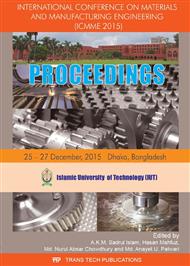[1]
RW. Le Maitre, A. Streckeisen, B, Zanettin, et al. Igneous Rocks: A classification and glossary of terms, recommendations of the international union of geological sciences, Sub-commission of the Systematics of Igneous Rocks. 2nd ed. Cambridge University Press, New York, (2002).
DOI: 10.1017/cbo9780511535581
Google Scholar
[2]
M. Singh, M. Garg, Perlite-based building materials – a review of current applications, Construction and Building Materials. 5 (1991) 75-81.
DOI: 10.1016/0950-0618(91)90004-5
Google Scholar
[3]
N. Burriesci, A. Carmelo, P. Antonucci, Physico-chemical characterization of perlite of various origins, Materials Letters. 3 (3) ( 1985) 103-110.
DOI: 10.1016/0167-577x(85)90008-4
Google Scholar
[4]
S. J. Johnstone, M. G. Johnstone, Minerals for the chemical and allied industries, 2nd ed., Chapman and Hall, London, (1961).
Google Scholar
[5]
J. S. Luongo, US Patent No 6, 251, 979 B1. (2001).
Google Scholar
[6]
S. Yilmazer, M. Ozdeniz, The effect of moisture content on sound absorption of expanded perlite plates. Building and Environment, 40 (2005) 311-318.
DOI: 10.1016/j.buildenv.2004.07.004
Google Scholar
[7]
W. P. Dube, L. L. Sparks, A. J. Slifka, Thermal conductivity of evacuated perlite at low temperatures as a function of load and load history, Cryogenics, 31(1991) 3-6.
DOI: 10.1016/0011-2275(91)90183-w
Google Scholar
[8]
T. Kendall, No sign of the bubble bursting – perlite uses and markets, Industrial Minerals, (2000) 51-59.
Google Scholar
[9]
B. Rodsky, US Patent 2, 858, 227. (1958).
Google Scholar
[10]
B. Gray, US Patent 4, 042, 406. (1977).
Google Scholar
[11]
P. B. Shepherd, R. L. Dolin, US Patent 5, 256, 222. (1993).
Google Scholar
[12]
JH. Hill, US Patent 4, 126, 512, (1978).
Google Scholar
[13]
H. Aglan, M. Morsy, et al, Evaluation of fiber reinforced nanostructured perlite-cementitious surface compounds for building skin applications, Constr. Build. Mater. 23 (2009) 138–145.
DOI: 10.1016/j.conbuildmat.2008.01.010
Google Scholar
[14]
J. Miscall, C. E. Rahr, US Patent 2, 626, 864, (1953).
Google Scholar
[15]
N. Sherman, J. H. Cameron, US Patent 4, 297, 311, (1981).
Google Scholar
[16]
H. G. Seybold, US Patent 2, 705, 198, (1955).
Google Scholar
[17]
A. Vimmrova, M. Keppert, L. Svoboda, R. Cerny, Lightweight gypsum composites: Design strategies for multi-functionality, Cement and Concrete Composites, 33 (2011) 84-89.
DOI: 10.1016/j.cemconcomp.2010.09.011
Google Scholar
[18]
I. B. Topcu, B. Isikdag, Effect of expanded perlite aggregate on the properties of lightweight concrete, Journal of Materials Processing Technology, 204 (2008) 34-38.
DOI: 10.1016/j.jmatprotec.2007.10.052
Google Scholar
[19]
A. Colak, Density and strength characteristics of foamed gypsum, Cement and Concrete Composites, 22 (2000) 193-200.
DOI: 10.1016/s0958-9465(00)00008-1
Google Scholar
[20]
J. Skujans, A. Vulans, I. Uldis, A. Aboltins, Measurements of heat transfer of multi-layered wall construction with foam gypsum, Applied Thermal Engineering, 27 (2007) 1219–1224.
DOI: 10.1016/j.applthermaleng.2006.02.047
Google Scholar
[21]
D. Shastri, H. S. Kim, A new consolidation process for expanded perlite particles, Construction and Building Materials, 60 (2014) 1-7.
DOI: 10.1016/j.conbuildmat.2014.02.041
Google Scholar
[22]
H. S. Kim, US Patent 2014/0033953 A1. (2014).
Google Scholar
[23]
H. S. Kim, M. M. Islam, Syntactic foams as building materials consisting of inorganic hollow microspheres and starch binder, in: D. C. Cornejo, J. L. Haro (Eds. ), Building materials: properties and performance and applications, Nova Publishers, New York, 2009, p.1.
Google Scholar
[24]
H. S. Kim, P. Plubrai, Manufacturing and failure mechanisms of syntactic foam under compression, Compos. A: Appl. Sci. Manuf., 35 (2004) 1009–1015.
DOI: 10.1016/j.compositesa.2004.03.013
Google Scholar
[25]
M. M. Islam, H. S. Kim, Novel syntactic foams made of ceramic hollow microspheres and starch – theory, structure and properties, J. Mater. Sci., 42 (2007) 6123–6132.
DOI: 10.1007/s10853-006-1091-7
Google Scholar
[26]
M. M. Islam, H. S. Kim, Manufacture of syntactic foams: pre-mold processing, Mater. Manuf. Processes, 22 (2007) 28–36.
DOI: 10.1080/10426910601015857
Google Scholar
[27]
M. M. Islam, H. S. Kim, Manufacture of syntactic foams using starch as binder: post-mold processing, Mater. Manuf. Processes, 23 (2008) 884–892.
DOI: 10.1080/10426910802413661
Google Scholar
[28]
M. M. Islam, H. S. Kim, Pre-mould processing technique for syntactic foams: generalised modelling, theory and experiment, J. Mater. Process Technol., 211 (2011) 708–716.
DOI: 10.1016/j.jmatprotec.2010.12.006
Google Scholar
[29]
A. G. Celik, Investigation on characteristic properties of potassium borate and sodium borate blended perlite bricks, Journal of Cleaner Production, 102 (2015) 88-95.
DOI: 10.1016/j.jclepro.2015.04.114
Google Scholar
[30]
Y. A. Owusu, Physical-chemical study of sodium silicate as a foundry sand binder, Advances in Colloid and Interface Science, 18 (1982) 57-91.
DOI: 10.1016/0001-8686(82)85031-8
Google Scholar
[31]
J. Karger-Kocsis, Editorial corner - a personal view Water glass – an alternative precursor for sol-gel derived solica nanofiller in polymer composites?, Express Polymer Letters, 8(12) (2014), 880-880.
DOI: 10.3144/expresspolymlett.2014.89
Google Scholar
[32]
M. Arifuzzaman and H. S. Kim, Novel mechanical behaviour of perlite/sodium silicate composites, Construction and Building Materials, 93 (2015) 230-240.
DOI: 10.1016/j.conbuildmat.2015.05.118
Google Scholar
[33]
M. Arifuzzaman and H. S. Kim, A model of foam density prediction for expanded perlite composite, 3rd Asia Conference in Mechanical and Materials Engineering (ACMME2015), July 2015, Chengdu, China.
Google Scholar
[34]
J.C. Rubio-Avalosa, A. Manzano-Ramıreza, J.G. Luna-Barcenasa, J.F. Perez-Robles, E.M. Alonso-Guzman, M.E. Contreras-Garcıa, J. Gonzalez-Hernandez, Flexural behavior and microstructure analysis of a gypsum-SBR composite material, Materials Letters, 59 (2005).
DOI: 10.1016/j.matlet.2004.07.054
Google Scholar


